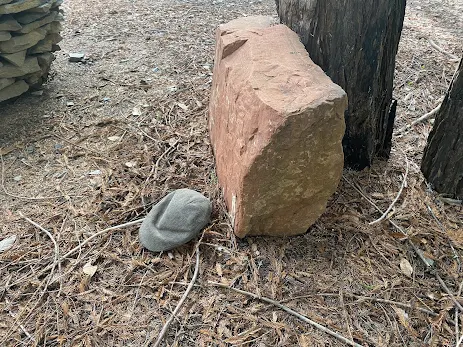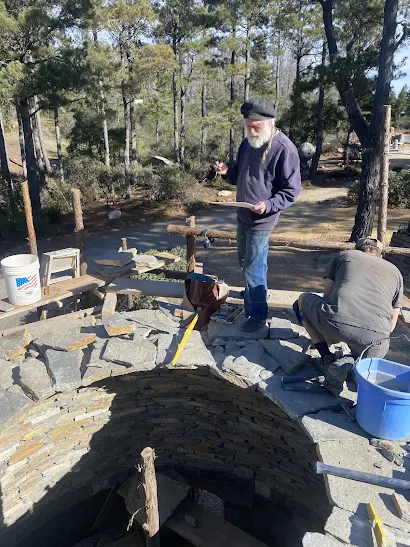"We had three large canvasses to work on, on the outside. We were all agreed that each exterior panel of dry wall needed breaking up somehow. It would have been too much wall area between arches, otherwise." writes Sean Adcock.
"John's initial idea was some sort of motif in each space, using the small white and black granite setts, each sett set to protrude in a hexagon star shape. Coming up with a sensible executable design was an issue, as was structure, and then given the basalt there was some question as to whether the protrusion would ever be noticed. John tried a few dry runs but nothing great seemed to be happening. Given the success of the small projection of the voussoirs over the arches, I think we almost got that one wrong however his eventual idea was a goody. "
"Anyway the idea of hexagons to in effect mirror the niche triangles in the pyramid wall, was as usual inspired. Even if it caused me the usual headaches… could we fit them in? Not sure how John came up with the right size ? I assume it was him, but they are just right. "
"For me, thickness was the issue. They had to fit in the walls behind the seats, not something that had been allowed for. They too would need a back, obviously another slab and yes we could just squeeze this in, and in fact the stone gods were smiling again, as it would make the top of the back of the interior seat too! We hadn’t found big enough slabs for the seat, and were going to sit one sawn edge slab on another. The niche slabs would need to be lower and we were of one mind that they needed to be complete. If they were in effect made up of the back of the seat there would be an obtrusive seam part way up. The second slab made the back of the seat more organic and the step another imperfect but perfect detail, even the little triangle of exposed stone that was left in the back of one was is just another little imperfection adding to the interest and beauty of the whole."

"The niches are as deep as we could build them, but their shallowness also works I think, although it was a little worrying for overlapping the slabs, thank goodness for flat schist stones, and good length into the wall beyond the slabs. As to the rest of their construction, I’m not placed to say how frustrating the process of constructing these hexagon niches was, other than noting John and Mark’s approaches differed. (Elizabeth worked on one of the hexagons too, with John offering advise) The three hexagons were to have relief sculptures in them eventually."

"My only other input here was the curb lintel. I know John wasn’t entirely convinced, I’m not sure I am even now, but the favoured shots are of doorways, so I'll reserve judgement until I've seen more photos of the finished temple . However having butchered so many curbs, (made them smaller, not showing off their splendour) it was good to honour three of them in longer form I think, and structurally my paramount thought was that as they extend beyond the end of niches, any load above them would be more likely to be transferred to the solid wall and not the thin skin/veneer forming the actual hexagon shape."
"My final contribution here was to have a throughstone on the centre of the top of each of these lintels, paying lip service to some structural theory or another 😊 In the photo a spider has made use of one waiting to be set on place, nature at its perfectly imperfect best?"
Mark is extending the height of the S W corner basalt with dressed granite curb blocks.
Some of the reclaimed San Francisco granite curbs came with with the original yellow street paint on them, which had to be painstakingly hammered and chiselled off. It's ironic to think that these lowly street curbs eventually turned into some of coolest blocks on the corner.
"As for the six outer basalt corners, and how to add more height to them. Much agonising over how to extend the basalt… having discarded the plainly mad idea of a second piece of basalt to stand on top. It was decided to do all sorts of different blocks to bring the uneven nights of the basalt column corners to an even height. The curbs were readily at hand and it sort of works. I wasn’t convinced when I last left, but the plinth has tied it all together.

















































